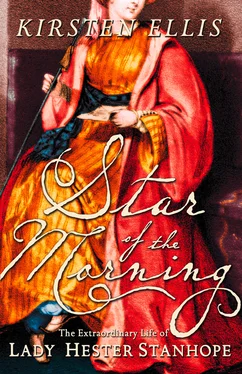1 ...6 7 8 10 11 12 ...30 Fear that London mobs might follow the example from across the Channel began to grow. At first, Pitt’s attitude was measured; although he evinced some sympathy for its early reforms, events swiftly moved to harden his heart: the mounting radicalism of the Jacobins, and news of the grisly butchering of priests and prisoners in France, caused him and many others who had previously been supportive to feel revulsion for the sans-culottes. Despite this, Earl Stanhope believed France would remain true to the virtues of liberty and equality. From that autumn, he and his former brother-in-law would regard one another as little better than enemies.
*There was a family connection to the Banks through Lady Mahon, for one of her uncles, Henry Grenville, had married Banks’s aunt, Eleanor Margaret. Their young daughter, Louisa, one of Banks’s cousins, was also cousin to the Pitt sisters, and was a great friend of Lady Mahon’s sister Harriot, who was then nineteen.
*Perhaps it was her extreme discretion and tact that led the banker, Thomas Coutts, to declare Lady Chatham ‘the cleverest man of her time, in politics or business’. The Pitt women, especially in their maturity, seem to have been altogether formidable.
*The heroic image of the dying statesman collapsing in Parliament, surrounded by more than fifty noblemen, would be committed to legend by an expatriate Bostonian, painter John Singleton Copley, in his painting The Death of Chatham. It took Copley two years to complete, painstakingly recording each detail of dress and interior, with most of the portraits made from life, and was regarded by many as the greatest historical painting ever done in England.
*Writing in 1793 of what he termed ‘the era of Jacobinism’, Sir Nathaniel Wraxall noted ‘it was then that pantaloons, cropt hair, and shoestrings as well as the total abolition of buckles and ruffles, together with the disuse of hair powder, characterised men, while the ladies, having cut off those tresses which had done so much execution, exhibited heads rounded à la victime et à la guillotine , as if ready for the stroke of the axe’.
As the French Revolution raged, everyone in London knew about ‘Citizen Stanhope’. He was mercilessly lampooned in satirizing cartoons by Gillray, who enjoyed depicting him as an emaciated, wine-drinking sozzle-head rallying cockade-wearing mobs, usually with an equally emaciated, vexed-looking Pitt lurking about in the background.
As far as the Stanhope children were concerned, their father the freedom-lover was a domestic tyrant. Hester began to mimic him; demanding that her siblings never enter a room unless they first sent a servant to ask whether they could be admitted. She disapproved of her father’s many ‘republican’ measures, such as doing away with the carriage and horses his wife had relied upon to ferry her about. Louisa reacted with predictable exasperation. By then the relationship between them was becoming irretrievable. Hester went to elaborate lengths to keep the peace. In her own words:
Poor Lady Stanhope was quite unhappy about it: but when the whole family was looking glum and sulky, I thought of a way to set it all right again. I got myself a pair of stilts, and out I stumped along a dirty lane, where my father, who was always spying about through his glass, could see me.
So when I came home he said to me:
‘Why little girl, what have you been about? Where was it I saw you going upon a pair of – the devil knows what? – eh, girl?’
‘Oh! Papa, I thought, as you had laid down your horses, I would take a walk through the mud on stilts, for you know Papa, I don’t mind mud or anything – ’tis poor Lady Stanhope who minds these things, for she has always been very accustomed to her carriage, and her health is not very good.’
‘What’s that you say, little girl,’ said my father, turning his eyes away from me, and after a pause, ‘Well little girl, what say you if I brought a carriage again for Lady Stanhope?’
‘Why papa, I would say it was very kind of you.’
‘Well, well,’ he observed, ‘we will see; but damm it! No armorial bearings.’
So, some time afterwards, down came a new carriage and new horses from London, and thus by a little innocent frolic I made all parties happy again. 1
Hester makes her father sound quite acceptably human, not at all a monster, and goodhearted beneath his somewhat autocratic exterior. Despite her claim, her ruse did not alter the growing coolness between her father and Louisa, whom all the children called ‘Mama’. Hester was old enough to observe cracks in the marriage and noted that ‘we children saw neither one nor the other’. It was usually Grizel who watched over the girls as they dressed for local balls and dances. ‘The Three Graces’, as she called them, were often up ‘all night, at least until five … dancing their hearts out’. But Grizel noted that Stanhope regularly took his daughters ‘some sixteen miles over the heavy Kent roads, waits patiently … and return[s] at seven in the morning’. 2 He did this several times a week over the winter ‘season’, for at least three years. It is hardly the picture of an unloving father.
Acutely aware of her father’s embarrassing behaviour, Hester’s letters are primarily concerned with finding creative ways around his restrictions on her movements. Unlike most daughters of her generation, Stanhope was doing his best to discourage her from having anything to do with families he thought too ‘aristocratical’ or ‘too bourgeois society’. To her closest friend from this time, Evelyn St Clare, Hester complained about his guests. He spent much of his time with Varley, his great ally and friend, and the blacksmith to whom he apprenticed his sons. ‘Oh defend me from Citizens and Philosophers if this is the life they lead.’ But she was also proud of her father’s brilliance.
Hester came of age in the 1790s, a time of revolutionary enthusiasm and political agitation that created a generation of thinkers, poets and artists. But it also ushered in a new wave of repression in Britain, for which her uncle Pitt was directly responsible. He feared civil strife, whether it stemmed from revolutionaries, anarchists or reactionary ‘Church and King’ mobs. Pitt regarded societies like the Revolution Society, and the Corresponding Societies, which by now had acquired hundreds of members, especially in the industrial centres of the north and in Scotland, as a particular threat.
Unconcerned, Earl Stanhope forged strong ties with many of the Revolution’s loftier theorists, notably the Marquis de Condorcet, the mathematician and Revolutionary martyr, whom Stanhope felt to be his true brother-in-arms, and the Duc de La Rochefoucauld. * Stanhope’s pacifist views were well known to these Frenchmen, as was his desire to see France and England ‘united by indissoluble bonds’. †
Hester was almost seventeen when Louis XVI was guillotined. Although reluctantly drawn into war, Pitt was of the widely-held opinion that this could only be a limited conflict. In fact, the conflict between the traditional foes would ultimately last, short intervals aside, for twenty-two years. Even Pitt’s great rival Charles James Fox, who had condemned the ‘madness’ of the war, conceded that the French regime had taken on a criminal nature. Under Robespierre and the Jacobins, political prisoners of all backgrounds – out-of-favour Girondins and generals as well as Marie Antoinette – had been sent to the ever-clattering guillotine. Walpole wrote that its ‘horrors make one abhor Lord Stanhope and his priestly firebrands’ and derided his pronouncements as the ‘ravings of a lunatic, imagining he could set the world on fire with phosphorus’.
Читать дальше












